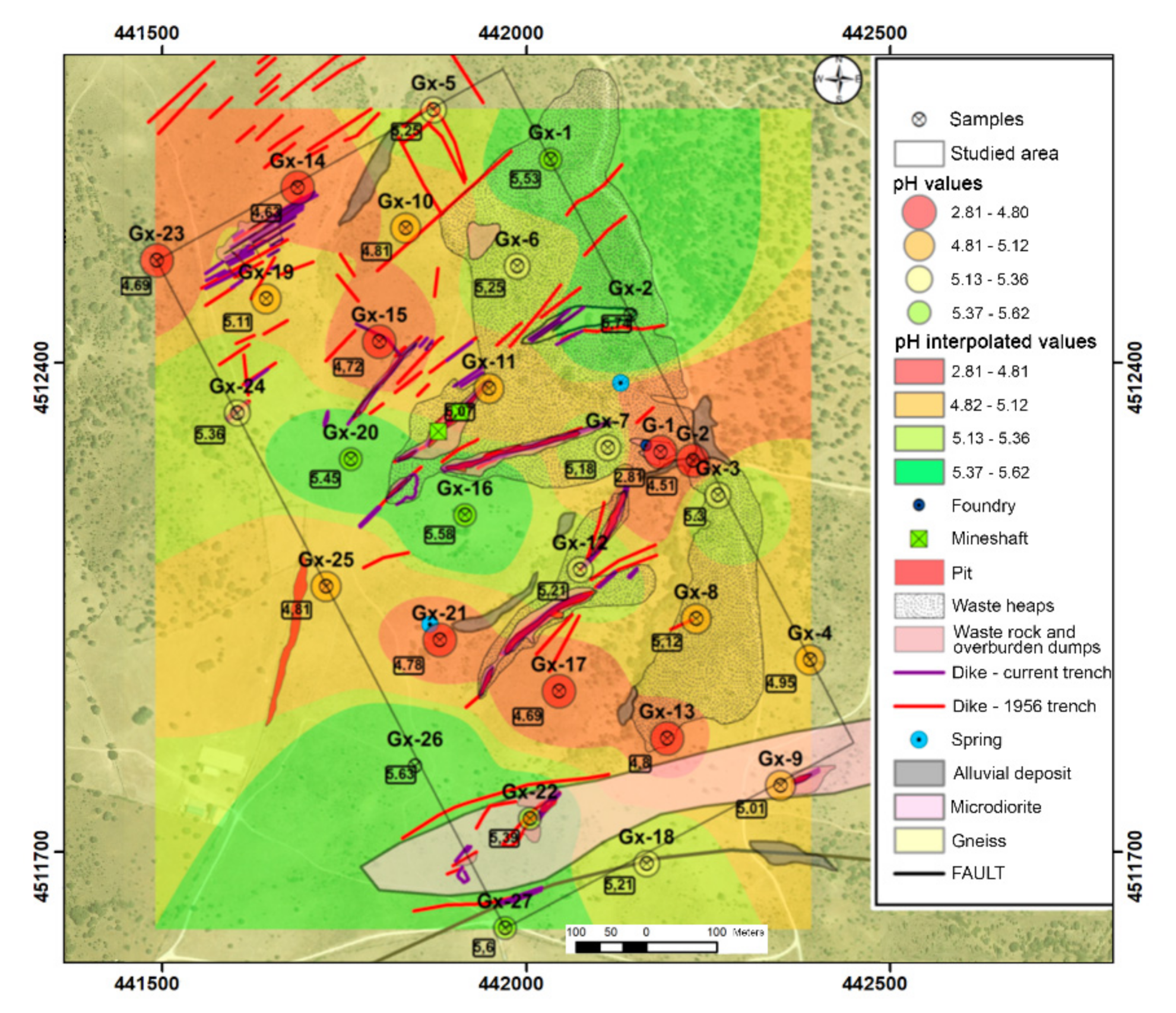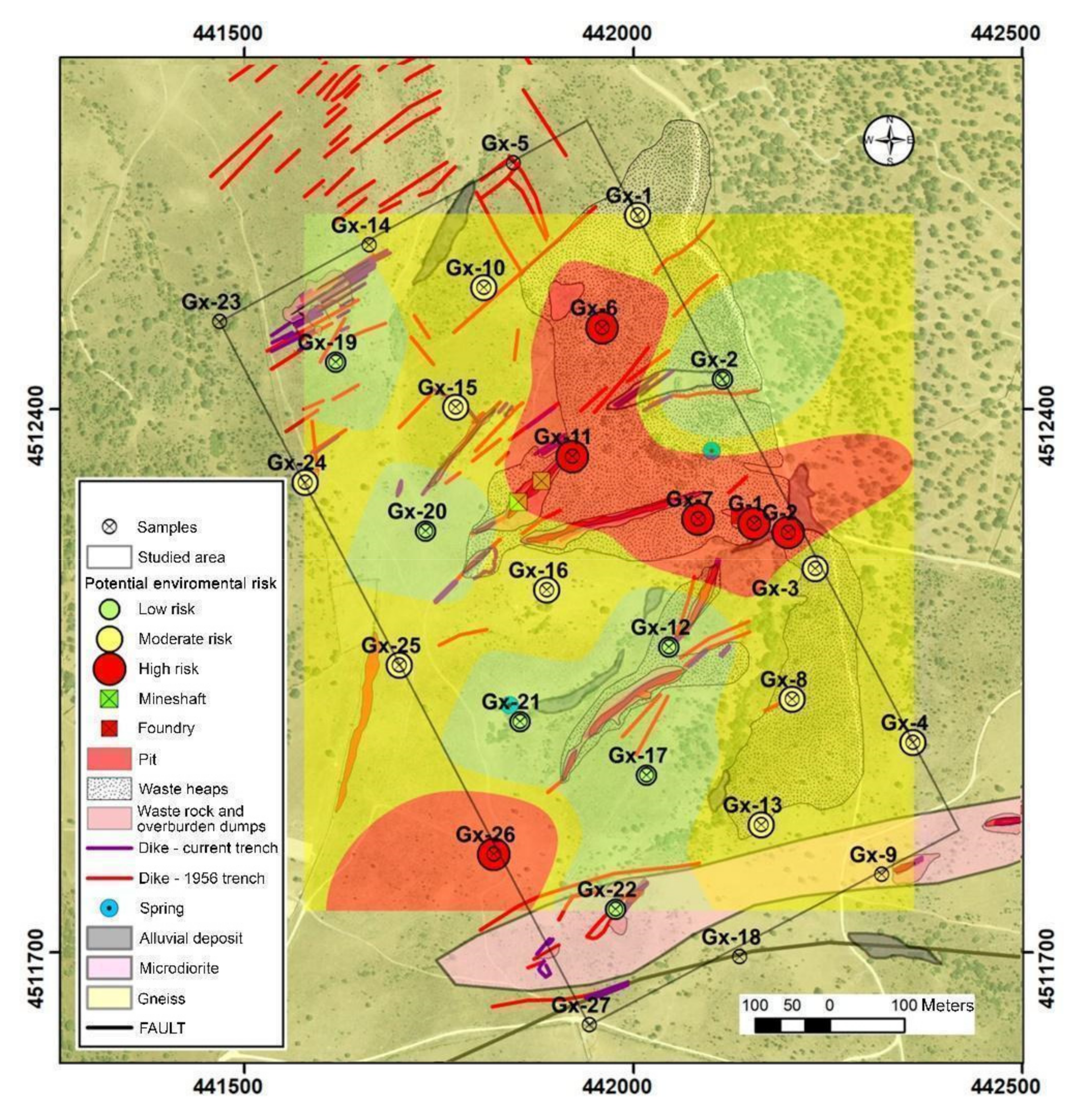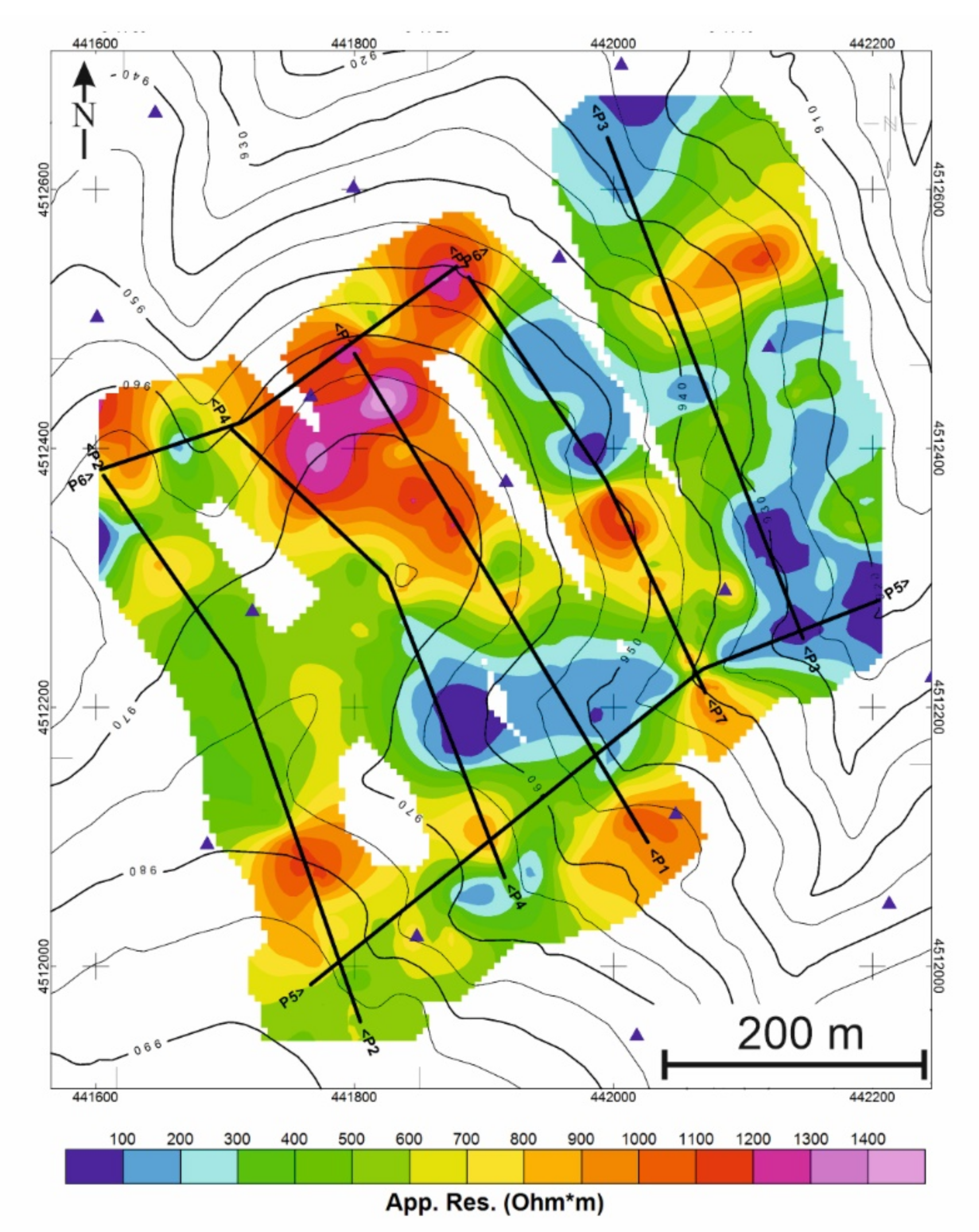3D Spatial Distribution of Arsenic in an Abandoned Mining Area: A Combined Geophysical and Geochemical Approach
Abstract
1. Introduction
2. Geological Setting
3. Materials and Methods
3.1. Geochemical Characterization: Data and Methods
3.1.1. Chemical Analysis
3.1.2. Assessment of Potential Environmental Risk
3.1.3. Geochemical Data Processing
3.2. Geophysical Data and Methods
3.2.1. Geophysical Data Processing
3.2.2. Resistivity tomographic inversion
4. Results and Discussion
4.1. Geochemistry of Soil Samples
4.2. Geophysical Results
4.2.1. Apparent resistivity results
- (a)
- The first group has values lower than 350 Ω m, reaching ρap values of 44 Ω·m. These values correspond to areas where clay and/or water are concentrated and coincide with the greatest development of natural soil, highly altered rock, and/or deposits resulting from anthropic activity. Its distribution extends in the ENE-WSW direction, which corresponds to a topographically depressed area, and in depth, this distribution is better defined with lower resistivity values.
- (b)
- The second group (ρap ranging from 350 to 750 Ω·m) indicates areas of intermediate apparent resistivity corresponding to weathered rock and/or soil.
- (c)
- The third group (ρap> 750 Ω·m), reaches values greater than 1500 Ω·m and corresponds to unaltered rock. These values are generally found in elevated areas with rocky outcrops with an ENE-WSW orientation but defined for lower resistivity value.
- (a)
- The first group ranges from 0 to 400 Ω·m, indicating areas of high conductivity and therefore low resistivity. These characteristics correspond to soils with high amounts of clay and/or the presence of water. These areas are usually found in small valleys, where accumulations of arsenic leached by water can be found. In some cases, areas with low resistivity correspond to areas of fracture in the gneisses.
- (b)
- The second group shows intermediate resistivities, ranging from 400 to 800 Ω·m) and correspond to weathered microdiorites and/or more developed soils. They are usually located close to the surface and with an average thickness lower than two meters.
- (c)
- The third group shows high resistivity values (from 800 to 1400 Ω·m) which correspond to the presence of fresh rock (gneisses) as well as mineralized quartz dikes. They are usually found in the elevated areas and below the soils, although in some sections there are lateral contacts with conductive areas, probably fractures.
4.2.2. D resistivity distribution
5. Conclusions
Author Contributions
Funding
Acknowledgments
Conflicts of Interest
References
- Paul, S.; Chakraborty, S.; Ali, N.; Ray, D. Arsenic distribution in environment and its bioremediation: A review. Int. J. Agric. Environ. Biotechnol. 2014, 8, 189. [Google Scholar] [CrossRef]
- Smith, E.; Naidu, R.; Alston, A. Arsenic in the Soil Environment: A Review. Adv. Agron. 1998, 64, 149–195. [Google Scholar] [CrossRef]
- Anthony, J.W.; Bideaux, R.A.; Bladh, K.W.; Nichols, M.C. Handbook of Mineralogy; Mineral Data Publishing: Tucson, AZ, USA, 2003. [Google Scholar]
- Gomez-Gonzalez, M.A.; Serrano, S.; Laborda, F.; Garrido, F. Spread and partitioning of arsenic in soils from a mine waste site in Madrid province (Spain). Sci. Total. Environ. 2014, 500, 23–33. [Google Scholar] [CrossRef] [PubMed]
- García-Lorenzo, M.L.; Marimón, J.; Navarro-Hervás, M.C.; Pérez-Sirvent, C.; Martínez-Sánchez, M.J.; Molina-Ruiz, J. Impact of acid mine drainages on surficial waters of an abandoned mining site. Environ. Sci. Pollut. Res. 2016, 23, 6014–6023. [Google Scholar] [CrossRef] [PubMed]
- Migaszewski, Z.M.; Gałuszka, A.; Dołęgowska, S. Arsenic in the Wiśniówka acid mine drainage area (south-central Poland) – Mineralogy, hydrogeochemistry, remediation. Chem. Geol. 2018, 493, 491–503. [Google Scholar] [CrossRef]
- Zawierucha, I.; Nowik-Zajac, A.; Malina, G. Selective Removal of As(V) Ions from Acid Mine Drainage Using Polymer Inclusion Membranes. Minerals 2020, 10, 909. [Google Scholar] [CrossRef]
- Tokoro, C.; Kadokura, M.; Kato, T. Mechanism of arsenate coprecipitation at the solid/liquid interface of ferrihydrite: A perspective review. Adv. Powder Technol. 2020, 31, 859–866. [Google Scholar] [CrossRef]
- Higueras, P.L.H.; Oyarzun, R.; Iraizoz, J.; Lorenzo, S.M.; Esbri, J.M.; Martinezcoronado, A. Low-cost geochemical surveys for environmental studies in developing countries: Testing a field portable XRF instrument under quasi-realistic conditions. J. Geochem. Explor. 2012, 113, 3–12. [Google Scholar] [CrossRef]
- Osinowo, O.O.; Falufosi, M.O.; Omiyale, E.O. Integrated electromagnetic (EM) and Electrical Resistivity Tomography (ERT) geophysical studies of environmental impact of Awotan dumpsite in Ibadan, southwestern Nigeria. J. Afr. Earth Sci. 2018, 140, 42–51. [Google Scholar] [CrossRef]
- Passaro, S.; Gherardi, S.; Romano, E.; Ausili, A.; Sesta, G.; Pierfranceschi, G.; Tamburrino, S.; Sprovieri, M. Coupled geophysics and geochemistry to record recent coastal changes of contaminated sites of the Bagnoli industrial area, Southern Italy. Estuarine, Coast. Shelf Sci. 2020, 246. [Google Scholar] [CrossRef]
- Villaseca, C.; Merino, E.; Oyarzun, R.; Orejana, D.; Perezsoba, C.; Chicharro, E. Contrasting chemical and isotopic signatures from Neoproterozoic metasedimentary rocks in the Central Iberian Zone (Spain) of pre-Variscan Europe: Implications for terrane analysis and Early Ordovician magmatic belts. Precambrian Res. 2014, 245, 131–145. [Google Scholar] [CrossRef]
- Capote, R.; Casquet, C.; Fernández Casals, M.J. La tectónica hercínica de cabalgamientos en el Sistema Central español. Cuad Geol Ibérica 1981, 7, 455–469. (in Spanish). [Google Scholar]
- Navidad, M.; Castiñeiras, P. Early Ordovician magmatism in the northern Central Iberian Zone (Iberian Massif): New U-Pb (SHRIMP) ages and isotopic Sr-Nd data. In Ordovician of the World; Gutiérrez-Marco, J.C., Rábano, I., García-Bellido, D., Eds.; IGME: Madrid, Spain, 2011; pp. 391–398. [Google Scholar]
- Pérez González, A.; Ruiz García, C.; Rodríguez Fernández, L.R. Torrelaguna Mapa Geológico de España, Escala 1:50000 1990, 509: 130 pp. (in Spanish). Available online: https://info.igme.es/cartografiadigital/geologica/Magna50Hoja.aspx?Id=509&language=es (accessed on 11 December 2020).
- González del Tánago Chanrai, J.; González del Tánago del Río, J. Minerales y Minas de Madrid; Consejería de Medio Ambiente: Mundi-Prensa, Madrid, 2002; 271p. (in Spanish) [Google Scholar]
- Recio-Vazquez, L.; Garcia-Guinea, J.; Carral, P.; Álvarez, A.M.; Garrido, F. Arsenic Mining Waste in the Catchment Area of the Madrid Detrital Aquifer (Spain). Water, Air, Soil Pollut. 2010, 214, 307–320. [Google Scholar] [CrossRef]
- ISO 10381-1: 2002. Soil Quality. Sampling. Part 1. Guidance on the Design of Sampling Programmes. Available online: https://www.aenor.com/normas-y-libros/buscador-de-normas/une/?c=N0039566 (accessed on 11 December 2020).
- ISO 17586: 2016. Soil Quality-Extraction of Trace Elements using Dilute Nitric Acid. Available online: https://www.iso.org/standard/60060.html#:~:text=ISO%2017586%3A2016%20specifies%20a,soils%20and%20soil%20like%20materials (accessed on 11 December 2020).
- García-Lorenzo, M.L.; Pérez-Sirvent, C.; Molina-Ruiz, J.; Martínez-Sánchez, M.J. Mobility indices for the assessment of metal contamination in soils affected by old mining activities. J. Geochem. Explor. 2014, 147, 117–129. [Google Scholar] [CrossRef]
- Li, J.; Kosugi, T.; Riya, S.; Hashimoto, Y.; Hou, H.; Terada, A.; Hosomi, M. Pollution potential leaching index as a tool to assess water leaching risk of arsenic in excavated urban soils. Ecotoxicol. Environ. Saf. 2018, 147, 72–79. [Google Scholar] [CrossRef] [PubMed]
- Usese, A.; Chukwu, O.L.; Rahman, M.M.; Naidu, R.; Islam, S.; Oyewo, E.O. Enrichment, contamination and geo-accumulation factors for assessing arsenic contamination in sediment of a Tropical Open Lagoon, Southwest Nigeria. Environ. Technol. Innov. 2017, 8, 126–131. [Google Scholar] [CrossRef]
- Ramírez-Pérez, A.; Álvarez-Vázquez, M. Ángel; De Uña-Álvarez, E.; De Blas, E. Environmental Assessment of Trace Metals in San Simon Bay Sediments (NW Iberian Peninsula). Minerals 2020, 10, 826. [Google Scholar] [CrossRef]
- Jiménez Ballesta, R.; Conde Bueno, P.; Martín Rubí, J.A.; García Giménez, R. Geochemical background levels and influence of the geological setting on pedogeochemical baseline concentrations of trace elements in selected soils of Castilla-La Mancha (Spain). Estudios Geológicos 2010, 66, 123–130. [Google Scholar] [CrossRef]
- Dentith, M.; Mudge, S.T. Geophysics for the Mineral Exploration Geoscientist; Cambridge University Press: Cambridge, England, UK, 2014. [Google Scholar]
- Reynolds, J.M. An Introduction to Applied and Environmental Geophysics; John Wiley and Sons: Hoboken, New Jersey, USA, 2011. [Google Scholar]
- Loke, M.; Barker, R. Rapid least-squares inversion of apparent resistivity pseudosections by a quasi-Newton method1. Geophys. Prospect. 1996, 44, 131–152. [Google Scholar] [CrossRef]
- Loke, M.H. Topographic modelling in resistivity imaging inversion. In Proceedings of the 62nd EAGE 968 Conference and Technical Exhibition, Glasgow, Scotland, England, UK, 29 May–2 June 2000. [Google Scholar]
- Loke, M.; E Chambers, J.; Rucker, D.F.; Kuras, O.; Wilkinson, P.B. Recent developments in the direct-current geoelectrical imaging method. J. Appl. Geophys. 2013, 95, 135–156. [Google Scholar] [CrossRef]











| pH | Electrical Conductivity (dS/m) | Total Content (mg/kg) | Acid Soluble As (µg/g) | |
|---|---|---|---|---|
| G-1 | 2.8 | 12,600 | 37,979.3 | 15.7 |
| G-2 | 4.5 | 1954 | 556.4 | 3.2 |
| Gx-1 | 5.5 | 777 | 44.1 | 0.05 |
| Gx-2 | 5.7 | 985 | 41.9 | 0.2 |
| Gx-3 | 5.3 | 719 | 44.1 | 0.02 |
| Gx-4 | 4.9 | 1230 | 45.8 | 0.03 |
| Gx-5 | 5.2 | 770 | 101.0 | 0.2 |
| Gx-6 | 5.2 | 815 | 120.7 | 0.3 |
| Gx-7 | 5.2 | 771 | 133.2 | 0.4 |
| Gx-8 | 5.1 | 697 | 60.3 | 0.03 |
| Gx-9 | 5.0 | 788 | 22.3 | 0.2 |
| Gx-10 | 4.8 | 747 | 71.5 | 0.04 |
| Gx-11 | 5.1 | 752 | 138.4 | 0.3 |
| Gx-12 | 5.2 | 729 | 33.0 | 0.02 |
| Gx-13 | 4.8 | 826 | 63.6 | 0.2 |
| Gx-14 | 4.6 | 809 | 28.7 | 0.2 |
| Gx-15 | 4.7 | 695 | 74.0 | 0.04 |
| Gx-16 | 5.6 | 752 | 59.9 | 0.2 |
| Gx-17 | 4.7 | 732 | 38.5 | 0.02 |
| Gx-18 | 5.2 | 760 | 41.2 | 0.35 |
| Gx-19 | 5.1 | 780 | 40.7 | 0.02 |
| Gx-20 | 5.5 | 760 | 26.3 | 0.01 |
| Gx-21 | 4.8 | 780 | 26.5 | 0.02 |
| Gx-22 | 5.4 | 1288 | 28.8 | 0.02 |
| Gx-24 | 5.4 | 807 | 54.3 | 0.03 |
| Gx-25 | 4.8 | 787 | 51.7 | 0.05 |
| Gx-26 | 5.6 | 780 | 92.4 | 0.1 |
| Mobility Index (AMI) | ||||
|---|---|---|---|---|
| Low | Moderate | High | ||
| Contamination factor (CF) | Low | Very low | Low | Moderate |
| Moderate | Low | Moderate | High | |
| High | Moderate | High | Very high | |
| Very high | High | Very high | Extreme | |
Publisher’sNote: MDPI stays neutral with regard to jurisdictional claims in published maps and institutional affiliations. |
© 2020 by the authors. Licensee MDPI, Basel, Switzerland. This article is an open access article distributed under the terms and conditions of the Creative Commons Attribution (CC BY) license (http://creativecommons.org/licenses/by/4.0/).
Share and Cite
Ruiz-Roso, J.; García-Lorenzo, M.L.; Castiñeiras, P.; Muñoz-Martín, A.; Crespo-Feo, E. 3D Spatial Distribution of Arsenic in an Abandoned Mining Area: A Combined Geophysical and Geochemical Approach. Minerals 2020, 10, 1130. https://doi.org/10.3390/min10121130
Ruiz-Roso J, García-Lorenzo ML, Castiñeiras P, Muñoz-Martín A, Crespo-Feo E. 3D Spatial Distribution of Arsenic in an Abandoned Mining Area: A Combined Geophysical and Geochemical Approach. Minerals. 2020; 10(12):1130. https://doi.org/10.3390/min10121130
Chicago/Turabian StyleRuiz-Roso, Jesús, Mari Luz García-Lorenzo, Pedro Castiñeiras, Alfonso Muñoz-Martín, and Elena Crespo-Feo. 2020. "3D Spatial Distribution of Arsenic in an Abandoned Mining Area: A Combined Geophysical and Geochemical Approach" Minerals 10, no. 12: 1130. https://doi.org/10.3390/min10121130
APA StyleRuiz-Roso, J., García-Lorenzo, M. L., Castiñeiras, P., Muñoz-Martín, A., & Crespo-Feo, E. (2020). 3D Spatial Distribution of Arsenic in an Abandoned Mining Area: A Combined Geophysical and Geochemical Approach. Minerals, 10(12), 1130. https://doi.org/10.3390/min10121130








